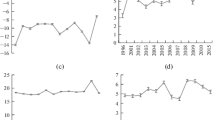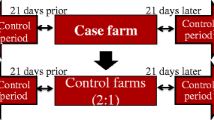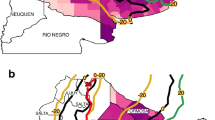Abstract
A study of thermal stress risk for cattle and buffalo was made in the Northeast Region of Thailand. Three-hourly air and dew-point temperatures from 15 selected meteorological stations for the period 1990 to 1999 were used to compute values of the temperature/humidity index (THI). Maps of isolines of THI values were generated by geographical software. A THI ≥ 84 was assumed to represent conditions where production losses would be likely to occur. Across the study area, the mean total number of days with THI ≥ 84 was 56. However, there was a strong north to south gradient across the region. The results suggest that the highest risk of loss to production in the cattle and buffalo industries is in the southern part of this region.










Similar content being viewed by others
References
Arya SP (2001) Introduction to micrometeorology. Academic Press, San Diego, pp 11–27
Blackshaw JK, Blackshaw AW (1994) Heat stress in cattle and effect of shade on production and behaviour: a review. Aust J Exp Agric 34:285–295
Bohuwech D (1995) An analysis of the relationship between deforestation and changes in climate and agriculture system: a case study of Northern Thailand (in Thai). Master’s thesis, Mahidol University, Nakorn Phatom, pp 1–130
Crane AJ (1982) Man’s impact on climate. In: Blaxter K, Fowden L (eds) Food, nutrition and climate. Applied Science Publishers, London, pp 313–351
Golden Software (1995) Surfer (win32) version 6.01. Golden Software Inc., Colorado
Gutman G (1984) Numerical experiments on land surface alterations with a zonal model allowing for interaction between the geobotanic state and climate. J Atmos Sci 41:2679–2685
Hahn GL (1999) Dynamic responses of cattle to thermal heat loads. J Anim Sci [Suppl 2] 77:10–20
Hahn GL, Mader TL (1997) Heat waves in relation to thermoregulation, feeding behavior and mortality of feedlot cattle In: Proceedings of the 5th International Livestock Environment Symposium Minneapolis, 29–31 May. ASAE, St Joseph, Mich, pp 563–567
Lee R (1978) Forest microclimatology. Columbia University Press, New York, pp 147–215
Lekplipol S (1998) The trend of extreme maximum temperature in summertime period of thailand for strong post-El Niño years (in Thai). The Meteorological Department, Bangkok, pp 1–81
Livestock Conservation Institute (1970) Patterns of transit losses. LCI, Omaha, Neb
McGregor GR, Nieuwolt S (1998) Tropical Climatology. Wiley, Chichester, pp 285–311
Office of Agricultural Economics (2001) Agricultural statistics of Thailand crop year 2000/2001 (in Thai). Center for Agricultural Information, Office of Agricultural Economics, Ministry of Agriculture and Co-operatives, Bangkok, p 83
Riehl H (1979) Climate and weather in the tropics. Academic Press, London, pp 39–80
Starr JR (1981) Climate and the need for housing. In: Clark JA (ed). Aspects of housing for animal production. Butterworths, London, pp 19–35
The Royal Forestry Department (1999) Forestry statistics of Thailand 2000 (in Thai). Data Center Information Office, the Royal Forestry Department, Bangkok, pp 1–7
West JW (1999) Nutritional strategies for managing the heat-stressed dairy cow. J Anim Sci [Suppl 2] 77:21–35
Yousef MK (1985) Stress physiology: definition and terminology. In: Yousef MK (ed) Stress physiology in livestock. Vol I, Basic principles. CRC Boca Raton, Fla, pp 3–7
Acknowledgements
The authors gratefully acknowledge K.G. Hubbard, School of Natural Resource Science, University of Nebraka, Lincoln, Pongsak Moncharoen, EGAT, Thailand, and Dr. Ed Sarobol, Department of Agronomy, Faculty of Agriculture, Kasetsart University, Thailand, for acting as consultants, the Meteorological Department, The Ministry of Communications, Thailand, for data collection, and the Royal Golden Jubilee Scholarship under the Thailand Research Fund for financial support for the project.
Author information
Authors and Affiliations
Corresponding author
Rights and permissions
About this article
Cite this article
Somparn, P., Gibb, M.J., Markvichitr, K. et al. Analysis of climatic risk for cattle and buffalo production in northeast Thailand. Int J Biometeorol 49, 59–64 (2004). https://doi.org/10.1007/s00484-004-0206-6
Received:
Revised:
Accepted:
Published:
Issue Date:
DOI: https://doi.org/10.1007/s00484-004-0206-6




